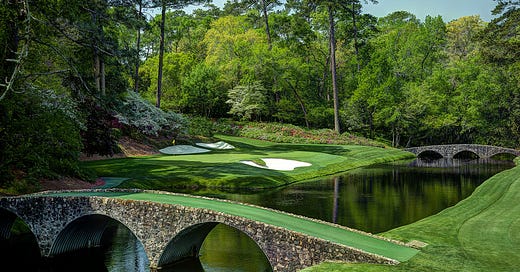Yes, this is a post about golf. It will come as no surprise to my family and friends that I’m writing about the game that nine-time Major winner Gary Player called “a puzzle without an answer.”
Since turning thirty, I am become golf dad, destroyer of scorecards, a walking-nine-holes cliché of a white guy in search of his ball. Golf, as the journalist Jim Bishop wrote, is played by twenty million mature American men whose wives think they are out having fun. Count me among them.
This is also a post about tradition in sports, about the purpose of games, and about our modern hunger for sacred spaces that might enclose us, bind us together, and make us new. Even if you know nothing about golf, I’d like to invite you into the headspace of the game: it’s stranger than you’d think.
To make things interesting, we’ll play a hole of golf together during this week’s quest. Your challenge: the Par 4 3rd hole at Augusta National. Choose wisely below; our collective decisions will determine the score—results to be revealed next week.
Grab your clubs, and take your practice swings. It’s time to tee off.
Augusta National Golf Club doesn’t invite the public to play—only to worship it from afar, to praise it with heavenly metaphors. Herbert Warren Wind, the legendary golf writer, said the course “seems to have been touched by divine hands.” Sportswriter Rick Reilly described Augusta as “a cathedral with sand traps.” Nick Paumgarten, writing in The New Yorker, called it “a Technicolor fantasyland embedded in an otherwise ordinary tract of American sprawl.”
Hole 3 is “Flowering Peach,” named for the trees located along the right side of the fairway, “developed for their showy blossoms and not their fruit.” It’s a short par four, considered by architect Alister McKenzie to be nearly perfect in its design and thus largely unchanged since 1932.
Your decision from the tee box is a classic risk/reward calculation: go for near the green and risk landing in the bunkers, or play it safe and lay back to the wider fairway.
Seve Ballasteros, a swashbuckling Spaniard known for his creative short game, called Flowering Peach “an unpredictable hole, full of drama.” Seve won the Masters twice, in 1980 and 1983. He was the first European to win an event that’s become synonymous with American spectacle. What is it about the Masters that’s enthralled so many for so long?
The obvious—perhaps too obvious—answer is tradition, a heritage that builds on itself year after year. There are no cell phones allowed on the course. Pimento cheese sandwiches still cost a buck fifty. The leaderboard remains hand-operated. Paumgarten called the Masters “a prelapsarian golf paradise, combining good manners and Southern delights with exclusion and self-satisfaction.”
But even Eden had to be made.
The event began in 1934, the brainchild of Bobby Jones and Clifford Roberts, with Jones admitting, “The name was born of a touch of immodesty—we wanted something that suggested the ultimate in golf.” Jones partnered with renowned Scottish course architect Alister MacKenzie to shape the layout of Augusta, inspired by the strategic subtleties of the Old Course at St. Andrews.
MacKenzie’s philosophy was to reward thoughtful decision-making rather than brute force, resulting in Augusta’s famously complex greens and dramatic risk-reward holes. From the start, Augusta was designed to test the mind as much as the swing. Stories of its difficulty—glass-like putting surfaces, shifting winds, deceptive fairways—grew over time.
Television helped seal the myth. CBS has broadcast the event every year since 1956, with reverent coverage that feels less like sports and more like liturgy. Viewers practically bow their heads to the proceedings. The whisper of Jim Nantz’s commentary, the slow pans over blooming azaleas, the ceremonial first tee shots by legends past: it all carries the weight of ritual.
While other cultural institutions crumble around us, the Masters endures, anchored by its moments. Jack Nicklaus’ thunderous charge to win the event at age 46. Fred Couples’ tee shot on the perilous 12th in 1992, somehow defying gravity to cling to the bank above Rae’s Creek, setting up his only major win. And the coolest golf shot of all time: Tiger Woods’ impossible chip on 16 in 2005—the ball pausing on the lip, the Nike logo turning toward the camera, the earth itself seeming to hold its breath before it fell.
Here’s another great moment from just yesterday. During the annual Par 3 contest, where players' families are invited inside the ropes before the tournament’s first round, Rory McIlroy’s four-year-old daughter rolled in a long (and absurdly difficult!) putt to cheers from the crowd.
What other televised sporting event makes space for something like this?
Alright, it’s your shot again on Hole #3. The wind is swirling. Do you flight a high pitch shot into the green, or bump a low runner under the breeze?
The 2025 Masters arrives at a strange moment in the golf world. The PGA Tour and LIV Golf are locked in a Cold War of formats and funding. Even if you haven’t followed golf’s civil war, this week it all collides in one place. Rory McIlroy is still searching for the green jacket (another ritualistic totem) that has so far eluded him. Several LIV golfers will contend, including Jon Rahm and Bryson Dechambeau. Young guns like Ludvig Åberg and Akshay Bhatia bring fresh energy. It’ll be two-time champion Bernhard Langer’s last Masters at the age of 67.
So the field is a mix of legacy and insurgency, legends and upstarts. Augusta has a way of exposing both.
The greens—carefully manicured, devilishly designed—are the real defense of the course. They're fast, contoured, and sloped in ways TV can’t quite capture. Approach shots must land on the right tier, in the right quadrant, with the right spin. Miss by even a little, and you're putting from 60 feet with two breaks and a ridge in between. Brandt Snedeker once said that putting at Augusta was like putting in a bathtub.
It should be simple, right? Roll the ball into the hole. But even golfing legends dread this aspect of the game. Ben Hogan, the patriarchal legend squarely on golf’s Mt. Rushmore, hated putting:
I have always contended golf is one game and putting is another. One game is played in the air, the other is played on the ground. If I had my way, every golf green would be made into a huge funnel. So that when you hit the funnel the ball would roll down a pipe into the hole. That way there would be no expensive upkeep of grass on the greens. And there would be much less misery among the golfers.
Every year around the Masters someone shares some version of the viral tweet: “Could the average golfer break par if they started every hole already on the green?” The answer, surprisingly, is a resounding yes, but the meme speaks as much to the perceived difficulty of Augusta as it does the earthly reality. The Masters is a place where even the basics, like putting, become treacherous.
No place is more treacherous than Amen Corner, yet another religious nod. The name was coined by writer Herbert Warren Wind in 1958 to describe the second shot on the 11th hole, all of the 12th, and the tee shot on 13—a stretch where nerves get exposed. Wind borrowed the term from a jazz song he liked, lending Augusta its most iconic nickname.
What makes Amen Corner so compelling is its unpredictability. The 11th hole is long and unforgiving. The 12th, a short par 3 over Rae’s Creek, is deceptive—winds gust, and players regularly dunk shots into the water. The 13th offers a chance for redemption but tempts golfers into risky decisions. It makes for fantastic television.
Back on Hole 3, it’s your turn to putt. This is it: you have ten feet to the hole. The surface slopes progressively right to left. Do you play the putt hard and fast, straight at the hole, taking out the break? Or do you hit it softer, playing the contour of the green, trusting your caddie’s read?
No matter how you played it—aggressive or cautious, high or low, bold or soft—you've now walked one hole at Augusta. Next week, we’ll see how our group scored. Until then, keep an eye on the tournament. Remember: what the Masters offers, beneath the coverage and the nostalgia, is a carefully curated environment where meaning still holds.
The rules don’t change. The rituals are intact. In a culture where so much feels provisional, performative, and in flux, the Masters remains a fixed reminder that some structures still work. It’s sort of like Christmas or an annual family vacation: it comes around once a year and enwraps us like a warm hug. I think it’s that feeling we worship, as much as the game itself.
So I invite you to join the tradition—watch the best players in the world suffer, just a little. It’s a lot of fun, I promise.
Here’s Quest 19:
Experience the Masters
Key Details:
As with the Play Balatro quest, this one is simple: just watch it!
Download the Masters App: no exaggeration, it’s the best sports apps ever made. The internet agrees. You can follow every player, watch every shot, and customize your feed in a way that actually works.
Drop your pick to win in the comments. I’m going with Collin Morikawa.










Thankfully I didn’t have to hold a club for this… great read!
I’m no golfer, but I’ve enjoyed walking courses with Josh in the past. Great exercise.
The one thing I took from the game is the idea of a “Ping” moment. That point in time when you finally do something you’ve struggled with for a while.
As I understand it, when you really connect the club and the ball the right way the golfer hears/feels the Ping.